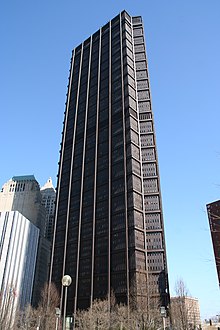US Steel
| United States Steel Corporation
|
|
|---|---|
| legal form | Corporation |
| ISIN | US9129091081 |
| founding | 1901 |
| Seat | Pittsburgh , United States |
| management | David B. Burritt, CEO |
| Number of employees | 29,000 |
| sales | 14,178,000,000 USD |
| Branch | steel |
| Website | www.steel.com |
| As of December 31, 2018 | |
The United States Steel Corporation , commonly known by the abbreviation US Steel , is an integrated steel producer with important locations in the USA and Central Europe .
structure
The company is based in Pittsburgh and is headquartered in the US Steel Tower . In terms of sales, the company ranks fifteenth in the world ranking of steel producers and is traded on the New York Stock Exchange . It was renamed USX Corporation in 1991 , which was reversed in 2001 when shareholders re-concentrated steel interests under the old company following the 1982 acquisition of Marathon Oil . Although it produces only slightly more steel than it did in 1902, US Steel is still the largest integrated steel company in the United States today.
founding
John Pierpont Morgan and Elbert H. Gary founded US Steel in 1901 by merging Andrew Carnegie's steel interests with their own, which were in the Federal Steel Company. US Steel was at times the largest steel producer and company in the world. In 1911, the US federal government attempted to use federal antitrust laws to break up US Steel. This attempt failed. But time and competitors managed almost the same thing. In its first year of business, US Steel produced 67% of all steel produced in the US. Today their share is less than 10%.
Even in its heyday, the company fascinated Wall Street and its investors more and more with its sheer size than with its efficiency or creativity. In 1901 he controlled more than two-thirds of US steel production. US Steel operated cautiously because of large loans taken out when it was founded - Carnegie insisted that his stake be paid out in gold bonds - and fears of antitrust litigation. Its competitors, particularly the Bethlehem Steel Company , led by former US Steel President Charles M. Schwab , used innovation earlier. By 1911, US Steel's market share in the growing market is reduced to 50%.
development

At its peak in 1953, US Steel reached an output of 35 million tons per year. During the Second World War , the company reached its maximum employment of more than 340,000 people in 1943. In 2000 the group employed just 52,500 people. The US federal government intervened on other occasions as well: President Harry S. Truman attempted to take over the steel giant in 1951 to resolve a crisis with the United Steelworkers of America union . But the Supreme Court blocked the takeover because they ruled the President did not have the constitutional right to seize the company.
President John F. Kennedy was much more successful in 1962 when he forced the steel industry to retract a price hike that Kennedy considered inflationary . The US federal government prevented the takeover of competitor National Steel in 1984 and political pressure from the US Congress forced US Steel to abandon plans to import slabs from British Steel . When National Steel went bankrupt in 2003 , US Steel took over the facilities.
In 1981, US Steel raised US $ 536.9 million from the sale of its coal interests. The next year, US Steel acquired Marathon Oil and a few years later Texas Oil & Gas as part of a diversification strategy . Towards the end of the 20th century, the company realized that it made the majority of its sales and earnings from its energy businesses. As a result, US Steel parted ways with Marathon and most of its non-steel activities with the exception of Transtar .
Union policy
US Steel followed Andrew Carnegie's employment policy of paying high wages against little union influence. The Amalgamated Association of Iron, Steel and Tin Workers Union , which organized the workers from the Homestead, Pennsylvania plant , disbanded itself after a violent strike in 1892. In the year of its establishment in 1901, US Steel experienced another strike. US Steel built the largest integrated steel mill in the northern hemisphere in Gary, Indiana , in 1906 . During the First World War, US Steel came to an impasse when, under pressure from the Wilson administration, it gave up its resistance to unions and allowed some to operate in certain factories. But it returned to its old politics after the end of the First World War and fought the unionization efforts of William Z. Foster of the AFL , the later head of the Communist Party of the USA , in "the land of the free and in the home of the brave".
During the 1920s, US Steel, like many other large employers in the United States, practiced a paternalistic employment policy with employee representation plans (ERP), which, as corporate unions, were funded by management. Ironically, these ERPs led to an important factor that led to the organization of the United Steelworkers union . The company gave up its tough anti-union stance in 1937 when Myron Taylor, as President of US Steel, approved the establishment of the Steel Workers Organizing Committee, led by the CIO's John L. Lewis . Taylor was an outsider who started to save US Steel during the Great Depression and had no sympathy for the company's long history of opposition to unions. The uprising of the United Automobile Workers on their sit-in strike in Flint, Michigan convinced Taylor that he and Lewis could create more stability for the company through collective agreements in a business-like manner.
Steel workers continued to have strained relationships with US Steel, but far less than other unionists with other employers in other US industries. Longer strikes began at US Steel in 1946 and 1959, but it was wages and salaries, but not the fundamental right to union recognition that led to violent strikes elsewhere. The 116 day strike in 1959 had a long-term effect on union-management relations at US Steel when 90% of all US Steel production was paralyzed. This strike opened the door to steel imports, which were previously a negligible factor. The long decline of the US steel industry had begun. The steel workers' union tried to avert the problem of competition with foreign imports by means of a so-called Experimental Negotiation Agreement (ENA) in 1974. It provided for arbitration in the event that no result could be reached at the negotiating table but left the union with the ability to strike.
In 1984, US Steel and other employers terminated ENA. In 1986 , US Steel locked thousands of its workers out when it closed a number of factories over a decline in orders as a result of feared strikes. In addition, US Steel and other steel producers demanded massive wage cuts from their employees at the beginning of the 1980s, since the wage cost share in the USA was 35%, while at the same time it was 25% in Germany.
International competition
In addition, the US steel industry has asked the US government to take action against what they termed foreign manufacturers dumping . US Steel, along with other leading US steel producers, filed a lawsuit against eleven steel supplier countries. This was combined with the request to return to a " fair market value ", which, however, was around US $ 100 per tonne higher than in Japan and around US $ 125 to 150 per tonne than in Germany. The Japanese and European steel companies, especially the private ones in Germany, had invested in the modernization of their plants right into the crisis and shut down old plants with public subsidies , while the US steel industry lived on the substance. At that time , the inexpensive continuous casting process in the USA only had a production share of 20%, while in the EC it already had a share of 39.16%. In Italy almost 50%, in West Germany 46% and in France 41% of the steel were produced using this process. Even Great Britain and Belgium were ahead of their US competitors with 27% and 26% respectively, who relied on their inexpensive location on the great North American lakes for a long time.
Although US producers were able to record a temporary increase in profits of 1051% compared to the same period of the previous year in 1981, despite declining crude steel production, neither the wage cuts by employees at the beginning of the 1980s nor the trade war between the USA and its European and Asian trading partners left the US steel industry as it was Regain strength and prestige.
Symbols
The US Steel Tower in Pittsburgh , Pennsylvania was named after the company, and the company's offices occupy a significant portion of the building. The US Steel Building, erected as a skyscraper on One Liberty Plaza in New York City in 1973 , was also named after the company. The Pittsburgh Steelers professional football team borrowed elements of its logo, a ring bearing three hypocycloids , from US Steel.
See also
literature
- H.-J. Ax: Steel Crisis and Western European Integration. The crisis as an obstacle or driving force for integration. In: Political quarterly. Volume 19, 2, Opladen 1978, pp. 157-200.
- David Brody: Laboratory in Crisis: The Steel Strike of 1919. 1965.
- Duncan Burn: The Steel Industry 1939-1959: A Study in Competition and Planning. 1961.
- W. Gaebe: Changes in the world economic division of labor. Using the example of the iron and steel industry. In: Geographical Rundschau. Braunschweig 1979.
- Thomas J. Misa: A Nation of Steel: The Making of Modern America 1865-1925. 1998.
- William Scheuerman: The Steel Crisis: The Economics and Politics of a Declining Industry. 1986.
- DG Tarr: Cyclical Dumping. The case of steel products. In: Journal of International Economics. Amsterdam 1979.
- Melvin I. Urofsky: Big Steel and the Wilson Administration: A Study in Business-Government Relations. 1969.
- Colston E. Warne (Ed.): The Steel Strike of 1919. 1963. (primary and secondary documents)
- Kenneth Warren: Big Steel: The First Century of the United States Steel Corporation 1901-2001. 2001.
- G. Wiemann: With all our might into new structures. In: Handelsblatt . 6./7. November 1981.
Web links
Individual evidence
- ↑ a b US Steel 2018 Annual Report , accessed March 16, 2019.
- ↑ "World Steel Association - Top steel-producing companies 2014" ( Memento of the original from March 4, 2016 in the Internet Archive ) Info: The archive link was inserted automatically and has not yet been checked. Please check the original and archive link according to the instructions and then remove this notice.


